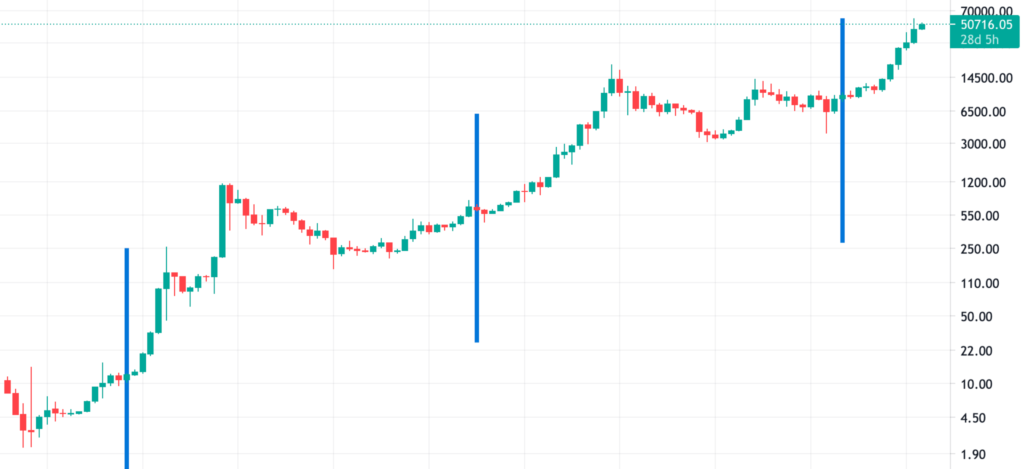On May 11th of 2020 the most recent Bitcoin halving took place. On every halving date the total supply of Bitcoin being mined daily is cut in half. Moving forward, there are now less Bitcoin being mined, and less Bitcoin sold by miners to run their mining operations. Historically as adoption increases, and halving’s happen, price goes up. Halving’s happen every 4 years (every 210,000 blocks), an illustration below.

Before the 1st halving, 50 Bitcoin were mined every 10 minutes. After the 1st halving 25 Bitcoin were mined every 10 minutes. After the 2nd halving 12.5 Bitcoin were minded every 10 minutes. And after the 3rd halving 6.25 are mined every 10 minutes. (This is where we are as of July 2nd, 2021, today) These mined Bitcoin are known as “the block reward”. At 144 blocks a day, that makes it where miners earn 900 Bitcoin per day as of this halving. As the halving’s continue to play out into the future, the 21 million total Bitcoin will be mined estimated in 2140.
Bitcoin’s pseudonymous creator(s), Satoshi Nakamoto decided upon this supply schedule before they disappeared. This supply schedule will never change. This is a key element as to why Bitcoin is valuable. Bitcoin has a sound monetary policy that will not be changed due to the consensus mechanism. I will not be diving into this today to keep to the topic of the halving.
What are Miners, and what is bitcoin mining?
Now, we must cover an important piece about the halving, and that is the role of the miners. The miners of Bitcoin are actually securing the network. By securing the network with their hash power (miners) they are given the block reward of Bitcoin! Without the security of the miners we would run into a double spend problem.
These block rewards create an incentive for miners to stay honest and secure the network. This incentivizes two things from not happening 1) double spending and 2) stopping transactions. This incentive structure is in place to encourage miners to follow the rules. Bitcoin puts an end to the double spending problem, and ends the ability for censorship of spending/value transfer.
As computing power grows and more miners come online Bitcoin becomes harder to attack, and the network is more secure. Any hacker would need a SUBSTANTIAL amount of hash power and get access to 51% of the miners to coordinate this type of attack.
I hope this was an easy and simple way for newbies to learn a little bit about how the halving works, and it’s role to Bitcoin. If you have any Q or feedback please hit me up on twitter.
